~ CREATIVE SOAPMAKING ~
September
Oatmeal Soaps
Selecting Vendors
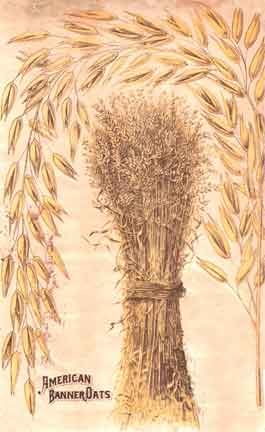
Contents
Oatmeal in Soapmaking—Why?
Rolled Oats and Oat Flour
Honey and Beeswax
Liquids—Milk, Cream, and Oat Milk
Cinnamon and Other Spices
Oatmeal, Milk, and Honey Fragrance Oils
Basic Oatmeal Soap and Variations
Oatmeal, Wheat Germ, and Buttermilk Soap
What Would I Do?
Selecting Vendors
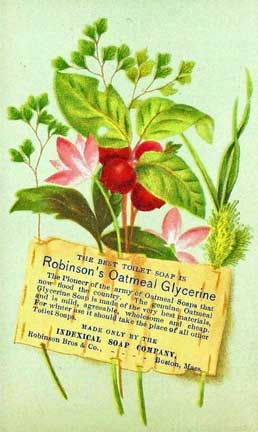
Oatmeal in Soapmaking—Why?
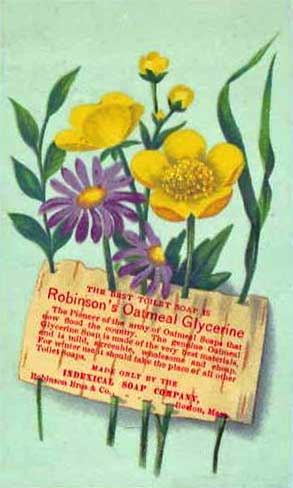
Oatmeal soap is very popular at markets and craft fairs. My friends who sell soap report that this one does well year after year. But exactly what is oatmeal soap, and why do we use oatmeal in soap?
First of all, many "oatmeal soaps" aren't actually made with oatmeal. They may be decorated with a light sprinkling of rolled oats, but basically, they're plain soap with an Oatmeal, Milk, and Honey fragrance, sometimes with an added touch of cinnamon fragrance. It's very appealing. But it's not really oatmeal soap.
Soaps have been made with oatmeal or oat milk for a long time, though, and the belief is that it's good for the skin. It's variously said to be good for oily skin, dry skin, skin irritations, the skin's acid mantle, and shingles; to be exfoliant, antibiotic, and anti-acne; and so on. But if you're selling soap, be careful not to make claims that violate labeling regulations. (Marie Gale's excellent book on Soap and Cosmetic Labeling can help here.)
Since I'm not a dermatologist, I can't say what oatmeal does for skin. Based on my own experience, I found oatmeal soaps to be rather drying.
In any event, oatmeal is very popular as a soap ingredient and scent.
Rolled Oats and Oat Flour
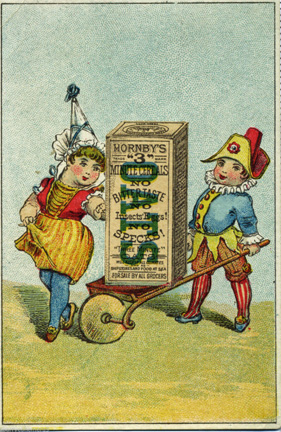
I've read recommendations to use hydrolyzed oats, baby oatmeal, instant oatmeal, and ordinary rolled oats in soap. When I checked the labels on hydrolyzed oats and baby oatmeal, the brands that were available to me had too many wild-card additives. I used rolled oats to make my oat milk, and bought oat flour to incorporate in soap as an exfoliant.
I wouldn't exceed one tablespoon of oat flour per pound of base oils. Soap can get soft and doughy if it has too much oatmeal in it. Oat flour didn't make my soaps "scrubby" the way some other additions will.
Some soapmakers soak dry ingredients like rolled oats and oat flour in some of the base oil for several hours before making soap. I tried it and didn't find it made much difference in my batches.
It's a good idea to be aware of temperature when using rolled oats or oat flour in soap. Depending on the size and shape of the mold, the soap may overheat as it's curing, to the point of forming a bull's-eye. Especially the first time you use a particular recipe in a particular mold, monitor the temperature, and if the soap seems to be getting hot, refrigerate it to slow it down.
Or, if you're fairly sure you're likely to get a soap that heats quickly—for example, if you're using a log mold—put the mold in the freezer after pouring. I freeze it for two hours for a two-pound (oils) batch. A larger batch might require more chilling.
Honey and Beeswax
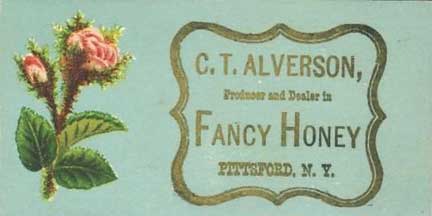
Honey, like any sugar, accelerates trace. It can also make soap turn brown.
When I use honey, I add it to the liquid, mix very well, and freeze them together. This helps to prevent browning and slows trace somewhat—but don't count on it. Any time you use an accelerant of any kind, be prepared to move quickly.
Also, keep honey amounts fairly low, to prevent stickiness and veins or blobs of honey in the finished soap. About 5% of the base oil weight is about as high as I'd go.
Keep an eye on soap with any fragile ingredient like honey in it. Sugars will contribute to overheating, so monitor your soap carefully.
Oatmeal soap may tend to be on the soft side, so you may choose to add a little beeswax. Beeswax melts at a higher temperature than most fats, and it's flammable. It has to be handled with care. It's also difficult to clean off of things.
Buy the beeswax in pastilles and start melting them several hours in advance of soapmaking. Fill a half-pint mason jar a quarter full of the pastilles and cover it. Put about two inches of water into the crock of a slow cooker and set it on Low. Put in the jar of beeswax and cover the crock. When you're ready to make soap, the beeswax is melted, and it's easy to remove the amount you want with a spoon. Don't try to clean out the jar, just keep it for the next time, adding more pastilles as needed.
Liquids—Milk, Cream, and Oat Milk
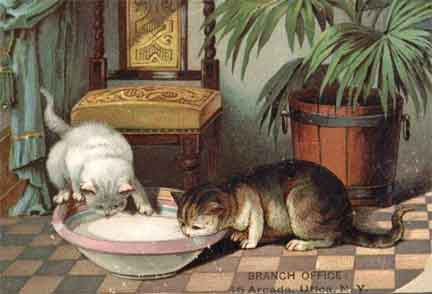
I've never figured the fat content of milk in my lye calculation. I don't even figure cream. If that means I have a little extra superfatting, so be it. I've never had a problem doing it this way, but if you do want to include it, you have to determine how many grams of milk fat are in your liquid. Ordinary milk is about 4% fat. Cream varies by brand and type, but the package should say. I don't use cream over 30% milk fat.
Then you do the math to see how much milk fat to list in your lye calculator.
You can easily make oat milk, and I prefer that to the commercial product, which may have additives like sugar and stabilizers.
Both oat and dairy milk should be used frozen. With dairy products, expect odd colors and odors while mixing. With higher-fat products, the lye mixture may be thick. This is normal.
I haven't detected any odd odors with oat milk, but as it melts and combines with the lye, gelatinous blobs form. I ignore them. They seem to be smoothed out by the stick blender. Anyway, they disappear.
Milk, oat milk, and cream may also be likely to overheat. So treat the same as recommended for honey, above.
Make oat milk by combining one part rolled oats with eight parts room-temperature distilled water. (That would be half a cup of oats to one quart water.) Let this mixture sit for fifteen or twenty minutes. Process in a blender or with your stick blender. Strain. (I used a "nut milk bag," but a clean flour sack towel or a fine strainer would do.) Or if you prefer to use steel cut oats, use one part oats to three parts water, and proceed exactly the same way.
Not everyone reacts to the fumes of milk soap, but if you do, they'll give you a sore throat. Use good ventilation. Of course, you should do that with all soapmaking—but if milk soap is a problem for you, use even better ventilation.
Cinnamon and Other Spices
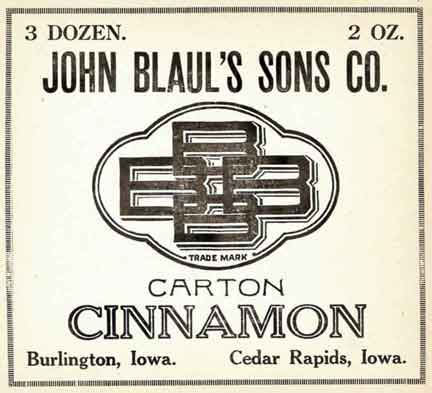
Spices are delightful. Fragrant, warming, comforting. It's easy to see why the Silk Road of early days was also the Spice Road. Almost everyone loves spices.
But the real thing is a skin irritant. Use ground spices very sparingly—no more than half a teaspoon per pound of base oils, if that. Use cinnamon essential oil in accordance with the vendor's recommendations. Or use a fragrance oil instead of an essential oil or ground spices.
Oatmeal, Milk, and Honey Fragrance Oils
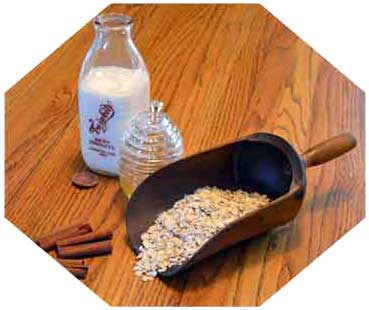
These vary a lot from different vendors. Some smell lovely, others are reminiscent of Play-Doh. All the OMH fragrance oils I've tried contain vanilla, and so will turn the soap brown.
Basic Oatmeal Soap and Variations
Here's a recipe you can use as the basis for different oatmeal soaps, along with some possible variations.
21 ounces (595 grams) olive oil
9 ounces (255 grams) coconut oil
9 ounces (255 grams) frozen liquid—oat milk, milk, chocolate milk, buttermilk, diluted yogurt, cream, or water
4.2 ounces (121 grams) lye
Use Cool Technique for mixing.
If you use yogurt, dilute 50-50 with distilled water, or more if you use Greek yogurt. I use natural whole milk yogurt, not lowfat. Don't use flavored yogurt—it has too much sugar and is likely to make the soap overheat.
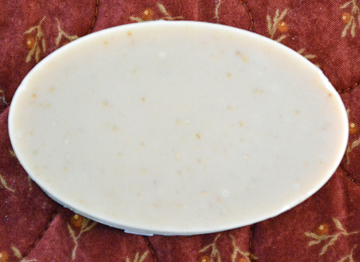
Basic recipe, using chocolate milk for the liquid and no added coloring. The chocolate contributes very little color. The soap has excellent creamy lather.
Variations
Add up to ¾ ounce (20 grams) of honey to the milk before freezing. Make sure it's very well mixed.
Add up to 1½ teaspoons cinnamon to the oil before adding the lye. Mix well with your stick blender.
Add up to 1½ tablespoons of oat flour or coarsely chopped rolled oats just before trace.
If desired, decorate the top with a light sprinkling of rolled oats. (This looks nice, but the oats are very scrubby—and they are going to end up down the drain.)
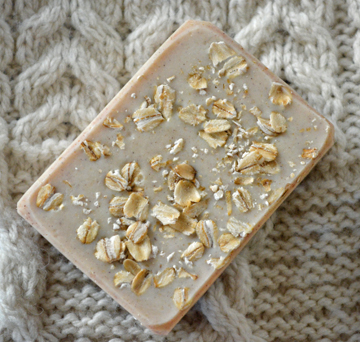
Basic recipe decorated with rolled oats. While the topping is attractive, the oats don't wash off quickly, and they tend to become hardened as the soap is used. I have heard complaints that toppings such as this can attract insects to the stored soap.
Oatmeal, Wheat Germ, and Buttermilk Soap
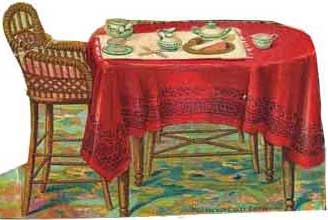
This soap has a very rich lather. Use only wheat germ oil that's refined, to avoid a vitamin pill odor in your soap.
1.5 ounces (43 grams) refined wheat germ oil
16.2 ounces (459 grams) olive oil
3 ounces (85 grams) almond oil
.3 ounces (8 grams) beeswax
9 ounces (255 grams) coconut oil
1 tablespoon oat flour or rolled oats
9 ounces (255 grams) buttermilk, frozen
4.2 ounces (120 grams) lye
Freeze buttermilk. Melt coconut oil and beeswax and combine with wheat germ oil, olive oil, and almond oil.
Proceed as for any Cool Technique soap. Cover and set in freezer for about two hours for a block mold, 45 minutes to an hour for a tray or individual molds.
Refrigerate a log mold overnight, a tray mold for several hours. Remove from refrigerator when spontaneous heat buildup stops.
Set in freezer again briefly before unmolding.
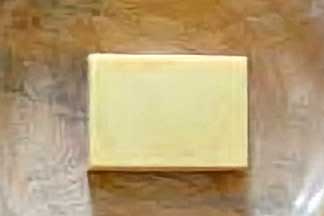
What Would I Do?

For my own use, I'd go fairly easy on oatmeal as an additive. It's noticeably drying. Of course, if you want that, it would be perfect.
I would not care to use any Oatmeal, Milk, and Honey fragrance I've ever tried. I think I'd use a cinnamon fragrance instead, or no fragrance.
Selecting Vendors
I get many, many questions about selecting vendors, and about the vendors I use personally. I have a Soapmaking Suppliers page on my web site—a sort of "yellow pages" guide—and I always give that link.
However, there really is a little more to it than that.
Online Vendors
One thing to consider is that you want to choose a vendor who is as close to you as possible, all other things being equal. Soapmaking supplies are often heavy and expensive to ship.
Compare prices. And compare quality.
Some vendors are better sources for smaller quantities. Others have much lower unit prices, but larger minimum quantities. Buy for your needs—oils and butters don't last indefinitely.
Pay attention to "blends." Especially with the more expensive butters, some vendors sell blends of the named butter with other fats. They label them honestly, but it's still easy to get confused.
Soapmaking supply vendors are by far the best source for fragrance oils and essential oils. The quality is better than what you get in a health food store or craft store, the price is far lower, and fragrance oils are more likely to be skin safe and appropriate for soap and lotion use.
I get pH strips and some soap molds from Amazon. They do tend to have everything.
“Brick and Mortar” Stores
Some supplies are easily available locally. Check big box stores, chain grocery stores, and restaurant supply stores for common fats such as olive oil, shortening, coconut oil, and lard. Depending on shipping costs, less common oils such as almond, hazelnut, and walnut may still be cheaper in local markets, health food stores, or gourmet stores than they would be if bought online and shipped.
In some states, you can get lye in hardware stores.
Restaurant supply stores and hardware stores are often good sources for cheap stainless steel cookware and utensils. And you do want the cheap pots—expensive ones are made to retain and distribute heat in cooking, and you need the opposite in soapmaking. For more thoughts on equipment, see January .





